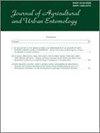Evaluation of Cluster Buster Fly Traps in a Large Commercial Establishment
Q2 Agricultural and Biological Sciences
引用次数: 1
Abstract
It is common knowledge that flies, particularly house flies, Musca domestica L. (Diptera: Muscidae), upon entering a building may eventually be found in a window, presumably trying to get outside. In addition to the entry of the occasional fly, flies in northern climes, e.g., blow flies (Calliphoridae), cluster flies (Pollenia rudis (F.); Polleniidae), and face flies (Musca autumnalis De Geer; Muscidae), will overwinter in large numbers in the attics of houses. When the weather begins to warm up,many of these flies find their way into the living areas of the house. They are attracted to the windows on the warmer, sunny side of the house (Pickens & Miller 1980, Burks et al. 1997, Cranshaw 2018). This can become a tremendous nuisance problem because a portion of the flies enter the living areas daily until all of the overwintering flies have left the attic. Having watched the behavior of flies in windows for many hours, it becomes obvious that flies fly up and down a glass pane with the anterior part of their head more or less touching the pane to some degree. This up and down flight continues until the fly, possibly fatigued, drops to the sill. Flies remain on the sill momentarily or for longer periods before resuming their up-and-down flight. Thus, it seems logical that windows would be good sites for placement of fly intervention devices, and many such devices are currently on the market. Most of these devices employ adhesive strips to capture flies, whereas others are pesticide-treated peelable stickers. In 2002 a different type of window trap, the Cluster Buster (Powder Trap Co., Collingwood, Ontario, Canada), appeared on the market. The trap fits flush against a windowpane and has a reservoir containing finely ground eggshells. At the top of the reservoir is a slit that is close and parallel to the windowpane once the trap has been mounted. This allows insects descending the windowpane to fall inside the trap. The finely powdered, chemically neutral eggshells act like quicksand and quickly engulf the struggling insect. The purpose of this study was to determine the types and numbers of insects captured by the Cluster Buster trap.大型商业机构集群捕蝇器的评估
众所周知,苍蝇,尤其是家蝇Musca domestica L.(直翅目:蝇科),在进入建筑物时,最终可能会在窗户里被发现,可能是想出去。除了偶尔的苍蝇进入外,北方地区的苍蝇,例如,飞蝇(丽蝇科)、簇蝇(Pollenia rudis(F.);Pollenidae)和面蝇(Musca autumnalis De Geer;蝇科)将在房屋阁楼中大量越冬。当天气开始变暖时,这些苍蝇中的许多会进入房子的生活区。他们被房子温暖、阳光明媚一侧的窗户吸引(Pickens&Miller 1980,Burks等人1997,Cranshaw 2018)。这可能会成为一个巨大的麻烦问题,因为一部分苍蝇每天都会进入生活区,直到所有越冬的苍蝇都离开阁楼。在观察了苍蝇在窗户里的行为数小时后,很明显,苍蝇在玻璃窗上来回飞行,头部前部或多或少地接触到了玻璃窗。这种上上下下的飞行一直持续到可能疲劳的苍蝇掉到窗台上。在恢复上下飞行之前,苍蝇会在窗台上停留片刻或更长时间。因此,窗户是放置苍蝇干预设备的好地方似乎是合乎逻辑的,目前市场上有许多这样的设备。这些设备大多使用胶带捕捉苍蝇,而其他设备则是经过农药处理的可剥离贴纸。2002年,市场上出现了一种不同类型的窗户陷阱,Cluster Buster(加拿大安大略省科林伍德的Powder trap Co.)。这个陷阱与窗格齐平,有一个储液器,里面装着磨碎的蛋壳。储液罐顶部有一条狭缝,一旦安装了存水弯,该狭缝就与窗格玻璃靠近并平行。这使得从窗户玻璃上下来的昆虫落入陷阱。细腻的粉末状、化学性质中性的蛋壳就像流沙一样迅速吞噬挣扎的昆虫。本研究的目的是确定集群巴斯特诱捕器捕获的昆虫的类型和数量。
本文章由计算机程序翻译,如有差异,请以英文原文为准。
求助全文
约1分钟内获得全文
求助全文
来源期刊

The Journal of Agricultural and Urban Entomology
Agricultural and Biological Sciences-Insect Science
CiteScore
1.40
自引率
0.00%
发文量
2
期刊介绍:
The Journal of Agricultural and Urban Entomology (JAUE) (Journal of Agricultural Entomology, Jan 1984 - Oct 1998 volumes 1-15) is published under the auspices of the South Carolina Entomological Society (SCES). The Journal publishes contributions of original research concerning insects and other arthropods of agricultural and urban importance to include those affecting humans, livestock, poultry, and wildlife. JAUE is particularly dedicated to the publication of articles and notes pertaining to applied entomology, although it will accept suitable contributions of a fundamental nature related to agricultural and urban entomology.
 求助内容:
求助内容: 应助结果提醒方式:
应助结果提醒方式:


